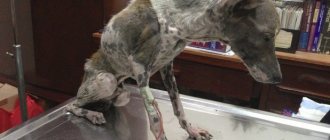8073Administration
Cucumber tapeworm in cats is a common disease among both stray cats and pets. This type of parasite has an impressive size compared to its counterparts.
Cucumber tapeworm in cats is a common disease among both stray cats and pets. This type of parasite has an impressive size compared to its counterparts. The length of an adult tapeworm varies from forty to eighty centimeters. However, cases have been recorded in which the helminth reached a full meter in length . The width of the worm does not exceed three millimeters, and its color varies from white to pale pink. In medicine, infection with cucumber tapeworm is called dipylidosis.
© shutterstock
The difficulty of treating cucumber tapeworm in cats lies in the structural features of the helminth itself. In each segment of its body, larvae can develop, viable on their own. It is important to ensure that after the cucumber tapeworm is expelled from the cat’s body, all the larvae leave with it.
Description and life cycle of the parasite
The cucumber tapeworm is a tapeworm of the cystoid class, which is so named because it resembles the sprouted seeds of a famous vegetable. The parasite causes a dangerous disease called dipylidia. The worm mainly affects domestic animals (including dogs and cats), but occasionally occurs in humans.
The worm grows up to 70 cm, but there have been cases when a parasite measuring a meter in size was recovered. Moreover, the thickness of its body is only 3 mm. Like most other worms, the tapeworm has male and female sexual characteristics (in different situations) and, if necessary, lays eggs without contact with another individual.
The parasite's head is equipped with four suction cups, as well as special hooks that help to stay in the host's body. The color is white with a pink tint.
ATTENTION! Each of the borage fragments contains a set of eggs, which, if necessary (for example, the loss of a body part) can develop into individual individuals. The parasite is extremely tenacious and fruitful.
Thus, the eggs of the bovine tapeworm become a formidable tool that is very difficult to fight. What is important is that it is not so easy to identify a worm. This can often be found out when a cat or dog falls exhausted.
Let's pay attention to an important point, namely, consider the life cycle of the parasite in order to understand how to deal with it:
- The worm enters the body through the mouth, slides down the esophagus and is fixed by suction cups on the intestinal walls . It stays there for about two weeks, actively feeds and finally forms into a sexually mature parasite.
- Eggs form in the body of the worm and after some time some of them leave the body with waste products. They may remain in a litter box at home or fall into the grass outside. Sometimes they cling to the fur around the anus and settle on the animal’s body.
- The eggs are eaten by intermediate hosts. For example, fleas or lice. By the way, this is how they can penetrate the human body. Let us remind you that cucumber tapeworm worms are also dangerous for pet owners.
- They develop in the body of lice and easily spread further to the main hosts : cats, dogs or humans.
- Thus, fleas land on the pet, leaving some of the eggs on the fur. The cat often washes itself and unknowingly licks off the new parasite. In rare cases, a pet swallows a flea and the eggs go directly into the intestines. Then the cycle of life of the cucumber tapeworm repeats.
Cucumber tapeworm in a cat
Cucumber tapeworm is associated with cucumber seeds.
This species is popularly called cucumber tapeworm due to the similarity of the segments to cucumber seeds.
The length of the tapeworm varies from forty to seventy centimeters , but some individuals grow up to one and a half meters. The width is usually no more than three millimeters. The color is white or with a pink tint. On the head of the worm there is a proboscis and four suckers, with which it is securely attached to the intestinal walls using fastenings in the form of hooks.
The parasite is a hermaphrodite and has a full set of female and male genital organs. The body containing the ripe eggs is cream-colored. Each section contains approximately thirty future worms, and each section can move and develop quite independently.
Cycle of life
Cats are considered the permanent hosts of the worm.
The full life cycle of a worm takes place with the participation of two hosts - a temporary and permanent host.
- Temporary hosts are fleas that live on the fur of animals, as well as human lice that swallow microscopic eggs of tapeworms.
- Cats, fur-bearing animals, dogs and humans are considered permanent owners
The helminth reaches a cat when the animal licks itself and accidentally swallows insects.
Localization
While licking, your pet may accidentally swallow a worm.
Inside, the helminth is localized in the small intestine and is attached to its wall using suction cups.
It remains in this state for about four weeks until it grows into an adult worm. The segments come out along with the cat's feces and remain in the external environment in all places where the cat is, and also a certain amount settles on the fur.
Symptoms of infection
As mentioned above, in the early stages it is very difficult to determine the presence of a parasite in the body.
In any case, if you pay close attention to your pet, the listed symptoms will be a reason to contact the clinic for prevention.
ATTENTION! The presence of worms in the small intestine provokes bleeding and food obstruction as the cucumber tapeworm develops (some people confuse it with bovine tapeworm).
Toxins and waste products of parasites affect the intestinal walls, mucous membranes and poison the body. They cause various allergies and other serious problems with the body.
Let's move on to the main symptoms of infection:
- Intoxication leads to vomiting, constipation and diarrhea.
- The cat refuses its favorite food. He eats little while not moving or, conversely, asks for his bowl to be filled several times a day.
- The cat often licks his anus and crawls on the floor, trying to relieve the severe itching.
- The pet sleeps a lot, rapidly loses weight, loses interest in games and affection from family members.
- A swollen belly, when the animal does not allow anyone to approach it and reacts aggressively to attempts to pet it. Moreover, the cat can meow pitifully and press its paws to the abdominal cavity.
- There is profuse salivation and purulent discharge from the eyes.
- The coat becomes dull, possibly causing hair loss.
It is worth understanding that a healthy adult animal can resist the parasite for a long time, but will eventually become weak and emaciated. In advanced cases, the pet will die. Infection is especially dangerous for kittens. The larvae quickly take over the growing body, develop rapidly from the abundance of food and cause irreparable harm to the baby’s body.
Signs of dipylidia
A single representative of the cucumber tapeworm in the intestines is not dangerous to humans and animals. It does not cause any unpleasant sensations to its owner, therefore, at the initial stage, dipylidiosis is asymptomatic. Signs of the disease begin to appear in the event of a massive accumulation of parasites. It is worth separately studying the symptoms of intestinal helminth damage in animals and in humans.
Symptoms in animals
As already noted, often the presence of helminths in the body of cats and dogs goes unnoticed, since there are no obvious symptoms. The presence of parasites may be indicated by problems with the gastrointestinal tract, stool disorders, intestinal bleeding and volvulus.
Possible infection from a cat
Symptoms of dipilidia often manifest as injury and damage to the mucous membrane of the small intestine. The animal may begin to have an allergic reaction to the waste products of helminths, which will affect its appearance. In the life cycle of the cucumber tapeworm, there is a migratory phase when it carries a huge number of pathogenic bacteria throughout the host’s body, which often causes various diseases.
The clinical picture of dipylidia in animals can be characterized as follows:
- pallor of the mucous membranes and skin;
- discharge from the eyes;
- disruption of the digestive system;
- tousled fur;
- convulsions;
- itching of the anal passage;
- stomach ache;
- nausea and vomiting;
- appetite uncharacteristic for the animal (increased or complete absence);
- diarrhea followed by constipation;
- bloating;
- fatigue, lethargy or increased excitability;
- exhaustion.
In rare cases, with severe infection, spontaneous release of helminth segments with feces is observed. Cucumber tapeworm in cats and dogs is more easily tolerated by adult animals; in kittens and puppies, infection with any helminths can be fatal.
Symptoms in humans
Cucumber tapeworm is extremely rare in humans, so there is no reliable and 100% assessment of its effect on the body and its reaction to parasitism. It is also not possible to determine the incubation period. Despite this, dipylidia in humans has pronounced symptoms.
Peddler - favorite dog
Among them are:
- loss of appetite, increased salivation;
- nausea and vomiting;
- diarrhea;
- severe abdominal pain, aggravated by palpation, bloating;
- pallor of the skin and mucous membranes;
- nervous excitability;
- headaches and dizziness;
- itching in the anus;
- rapid weight loss even with normal appetite.
Symptoms are accompanied by the release of mature segments from the anus, as well as their excretion along with feces.
Treatment at home
If two or three symptoms are confirmed, then you can finally confirm the presence of parasites at home. Cucumber tapeworm eggs are round or oval. Their size reaches 40-50 microns . Individual eggs are extremely difficult to notice, but they usually lie in groups of 20-30 units . It looks like small white spots. They stand out strongly against the background of feces.
In rare cases, you can see pieces of the body of the worm itself. Unfortunately, an accurate diagnosis can only be made after an examination by a veterinarian and collection of tests.
Diagnostics
- Fulleborn fecal analysis - a piece of feces is dissolved in a saline solution and, if larvae or their eggs are present, they float. The collection is examined under a microscope. The method is reliable, even to the point that it allows one to distinguish between different types of microorganisms.
- General blood analysis.
- Urine examination.
How to treat cucumber tapeworm infection? Much depends on a number of factors. Firstly, the type of parasite. Secondly, it depends on the degree of infection and the stage of development of the worm. Thirdly, on the age and immunity of the pet.
Let's look at medications that can get rid of the worm. Veterinarians often recommend the following medications:
- Kanikquantel+ . Effective for kittens from 3 weeks
- Quantum. Effective for kittens from 4 weeks
- Drontal (Moscow). The drug is used for animals weighing more than 2 kg. A separate product, Drontal JR, is used for smaller pets over 2 weeks of age.
- Fenasal. Sold in powder form. It is mixed with the cat’s favorite food at a concentration of 0.2 mg per 1 kg of animal.
- Bunamidine. Use 3 hours before meals at a concentration of 0.35 mg per 1 kg of animal.
- Fenagel (Moscow) . It is sold in the form of a cream that is mixed into cat food.
- Mebendazole. Used in a concentration of 0.4 mg per 1 kg of animal during feeding.
Antibiotics are often used, but they are prescribed only on the recommendation of a veterinarian based on the general health of the cat. To maintain the body, medicinal solutions are used, which are administered intravenously.
IMPORTANT! After taking any drug, usually a few hours later, the cat is given a laxative to get rid of parasites. Often several courses are prescribed with a month difference in application.
As for complications, they are possible with delayed treatment. He will not talk about total exhaustion and intoxication, which affects the functioning of internal organs. Let us note the most serious consequences:
- The gastric mucosa is affected - gastritis;
- Problems with the pancreas – pancreatitis;
- Problems with the gallbladder – cholecystitis;
- Problems with the small and large intestines – enteritis and colitis, respectively.
Much attention should be paid to a restorative diet. You can use expensive dry food or natural food rich in vitamins and minerals
Danger to humans
Cucumber tapeworm eggs enter the human body in the same way as animals. If you do not follow standard hygiene rules, the risk of infection is extremely high.
In addition, after going outside, it is advisable to wipe or wash your pet. It is enough to stroke a dog or cat on whose fur worm eggs have settled, and they easily penetrate to a person.
ATTENTION! It is worth thoroughly cleaning the tray, disinfecting the room and observing personal hygiene rules. Otherwise, a course of treatment with anthelmintic drugs will be required.
The cat must have a separate sleeping place. She should not sleep in bed with her owner for preventive purposes.
Life cycle of cucumber tapeworm
After the segments exit the intestines along with feces, some eggs end up on the animal’s fur, and then in all the places where the pet often visits.
These eggs feed on intermediate hosts, which are:
- Fleas.
- Dog lice eaters.
- Inside the intermediate host, cucumber tapeworm larvae develop into the subsequent form, cysticercoids.
Afterwards, the flea affected by the tapeworm is swallowed by the main owner - a cat, fox, dog, wolf, raccoon or even a person.
The cucumber tapeworm in cats (see photo) is the same length and size as in dogs and humans.
Prevention
The biggest source of infection is uncontrolled walking of pets. It is still not uncommon to see well-groomed animals next to stray cats.
This increases the chance of infection with a worm several times. Some owners use a special collar for pets. For cats, this no longer looks strange, but is done for safety reasons.
Precautionary measures
- Buy an anti-flea collar for your cat or bathe it with a special shampoo.
- Keep the room clean. Pay special attention to the cat's food bowl and litter box. Disinfect it at least several times after it is completely filled.
- Give your pets antihelminthic medications.
- Limit going outside. Do this once every few months.
- When returning from a walk, thoroughly wash your shoes and hands.
- Check your pet's fur for the presence of fleas, lice and other organisms. Also pay attention to stuck together hairballs and promptly identify bare areas where cat hair falls out.
- Wipe with disinfectant the places where the cat likes to be - window sills, floor areas, pieces of furniture.
- Once every six months, take your cat, especially a kitten, for examination to a veterinary clinic.
The cucumber tapeworm is an extremely unpleasant parasite that is difficult to detect even in its later stages. In most cases, a complete analysis by a specialist is required. Fortunately, getting rid of parasites is not difficult if you follow your doctor’s recommendations, do not violate the course of therapy and follow a therapeutic diet.
Increased vigilance of the owner when walking on the street will maximize the protection of the pet from the penetration of the cucumber tapeworm. And remember: dipilidia poses a great danger not only to the pet, but also to its owner.
Parasites are easily transmitted from humans to animals and vice versa.
How does dipylidia infection occur?
Dipylidiasis can affect both domestic and wild animals (wolves, foxes, jackals, etc.). Most often, homeless animals become infected with it.
The question is often asked: can a person become infected with cucumber tapeworm?
Yes, this parasite is also dangerous for humans, as it is transmitted through parasites that live on the fur of pets, with whom we constantly come into contact: we stroke, squeeze, pick up and take into bed.
Pets sit and lie on the same sofas, beds and armchairs as we do, and therefore it is quite natural that an almost invisible flea or whipworm, which has a pork tapeworm, can enter our body through the mouth, as, indeed, and other parasites.
Considering the widespread prevalence of pork tapeworm eggs and fleas as their carriers in the environment, they can reach us through contaminated meat, vegetables, and herbs.
A person cannot become infected directly from a domestic animal infected with pork tapeworm unless there is an intermediate host - a flea or whipworm.











